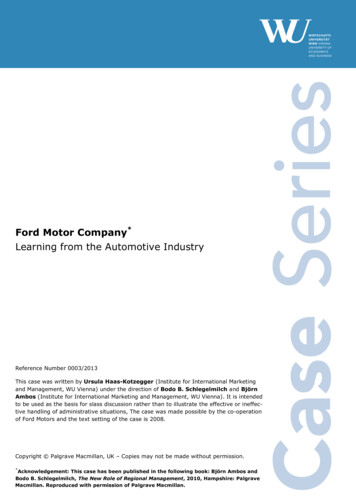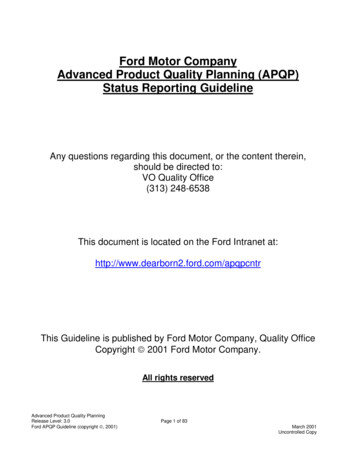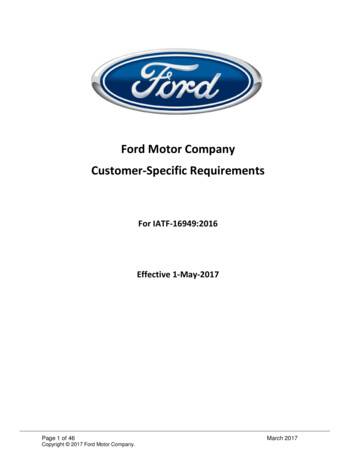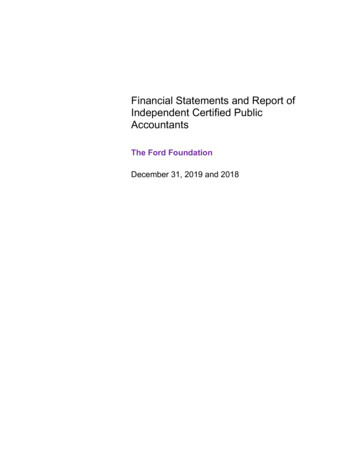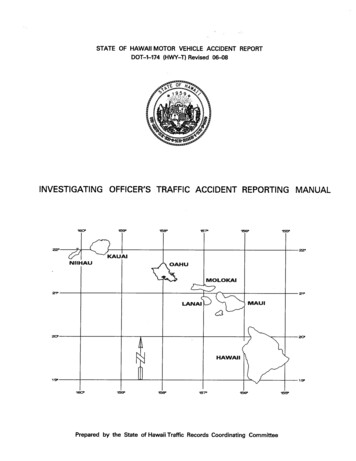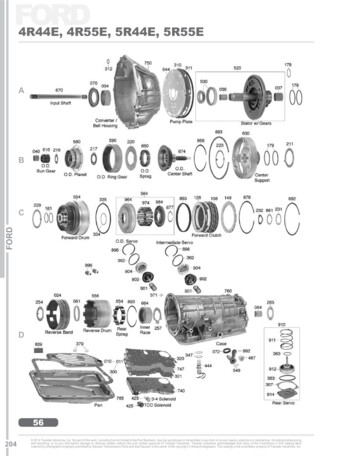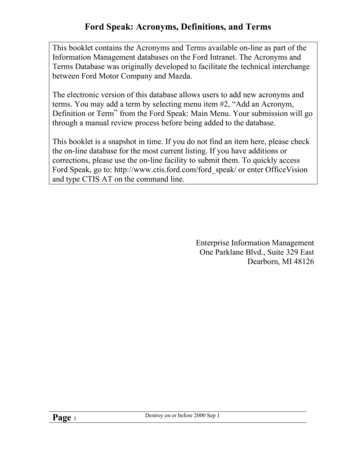
Transcription
Strategic Report forFord Motor CompanyRhett Dornbach-BenderBill SladeJoe ThorpeApril 20, 2009
Ford Motor Company (NYSE: F)Table of ContentsExecutive Summary . 3Company Overview. 4History . 4Business Model and Market Overview. 5Competitive Analysis . 7Internal Rivalry. 7Supplier Power . 9Buyer Power . 9Entry and Exit. 10Substitutes . 11Complements . 12SWOT . 13Strengths . 13Weaknesses . 13Opportunities . 14Threats. 14Financial Analysis . 15Overview . 15Profitability and Growth . 16Liquidity and Solvency . 18Strategic Recommendations . 20Divest Volvo . 21Factory and Supply Chain Management . 22Prepare for Liquidation of Chrysler and/or Bankruptcy of GM . 23Product Differentiation . 25Shift Production to Mexico and Eastern Europe . 26Expand Market Share in China and India. 27References . 28April 20, 20092
Ford Motor Company (NYSE: F)Executive SummaryFord Motor Company faces many strategic challenges during these volatile economic times.In the next month and a half, two of its major competitors may be forced to file forbankruptcy or liquidate assets. As of this writing, Ford is the most financially soundAmerican car manufacturer and possesses enough cash on hand to continue operationsthrough fiscal year 2009, provided there are no further dramatic deteriorations in the market.Analysts believe that the company will not need to seek government funding unless car salesfor 2010 are below 12 million. While Ford, like all major car companies at this time, facesserious challenges, we assert that opportunities exist during any time of crisis. We believethat Ford can, with our help, break even in fiscal year 2010 barring further macroeconomicdeterioration.This report makes the following recommendations to Ford Motor Company:1) Ford should continue attempts to sell off the Volvo brand. The funds from this saleshould provide Ford with increased flexibility during the coming year as well ascontribute to existing strategic goals.2) Ford should extensively prepare for the bankruptcy of Chrysler and/or GeneralMotors. Such bankruptcies pose a great deal of risk to Ford, including but notlimited to: the possibility that the government may chose a winner, the potential forGM to emerge from bankruptcy with a significant cost advantage, and supply chaindisruption resulting from bankruptcies of mutual suppliers. While we believe thatany liquidation of Chrysler should be viewed as a strategic opportunity, we remaindeeply concerned about how the future of GM may impact Ford. In the short term,we believe that Ford should continue to capitalize on its competitors’ instability andsteal market share.3) We have faith in management’s ‘One Ford’ strategy and believe that the Ford Fiestais poised for success in North America, if marketed correctly and executed properly.Continued differentiation through the creation of defining style and feature setexclusive to Ford vehicles is also a positive step in the long run.April 20, 20093
Ford Motor Company (NYSE: F)4) We recommend that, wherever possible, Ford should shift production from theUnited States and the Euro Zone to Mexico and Eastern Europe.5) We recommend that Ford exploit current opportunities in China and apply capital toramp up its sales and market share. In the long run, Ford must also focus onexpanding its share in India. We do not, however, recommend that Ford investsignificant capital in the Indian market at this time.We at Oasis Consulting believe that these recommendations are in line with the Fordphilosophy and are in touch with its history as a family owned company. It is important to notethat this report is only current as of April 20th, 2009. Industry circumstances are rapidly changing,and Ford’s optimal next steps cannot be fully expounded upon until specific informationregarding GM and Chrysler’s future is announced. Oasis Consulting looks forward to theopportunity to provide continued support for Ford Motor Company as the situation withChrysler and General Motors develops, and believe that this report sets forward the optimalstrategy for the company at this juncture in time.Company OverviewHistoryFord Motor Company was founded in 1903 by Henry Ford and has continuously remainedunder family ownership since this time. The company developed and implemented assemblyline production by the release of the Model T in 1909, and produced planes and vehicles forthe Allies in World War II. Ford has operated internationally since 1904, when it opened abranch in Canada to gain access to Commonwealth markets. For the first half of the 21stCentury, Ford remained the dominant car manufacturer within the market it had effectivelycreated. In 1956, Toyota exported its first automobile to the United States, and beganacquiring market share. In hindsight this was a turning point in the U.S. market, and as the21st Century drew to a close Ford faced declining market share and had difficulty remainingcompetitive in the global marketplace. Ford was particularly inhibited by substantial legacyApril 20, 20094
Ford Motor Company (NYSE: F)costs—primarily from employee pensions and healthcare benefits—and falling demand forits most profitable lines of vehicles.In 1996 the company launched the ‘Ford 2000’ initiative to streamline supply lines andreorganize the company’s worldwide operations into a more cohesive unit. In spite of someimportant successes, including the popular Ford Focus model and a streamlinedorganizational structure, costs at Ford remained higher than most of the firm’s competitors.In 2006, Ford posted its biggest operating loss to date: 12.6 billion. This coincided withcontinued deterioration in market share, with the majority of these losses being captured byToyota and General Motors. From 1997 to 2007, Ford’s United States market shareplummeted from 25% to 15%.In 2006, Alan Mulally was hired as CEO and took over a company at the precipice of failure.Mulally announced a new restructuring plan in 2006 entitled ‘The Way Forward’, designed to“better align capacity to demand”. At its core, this plan involved the closure of sevenassembly plants and strategic reorientation towards ‘One Ford’. Championed by Mulally,this strategy focuses on creating a standard Ford personality which is seen and felt withinevery automobile produced by the company. In addition, the plan entails standardizingchassis worldwide and a greater focus on the core Ford nameplate. As a part of this plan,Ford mortgaged all of its assets—both physical and intellectual property—in December2006 for a 23.4 billion line of credit. While originally seen as a risky and potentiallydesperate move, this timely acquisition of capital has made Ford the most stable of the BigThree carmakers. The company also divested some of its non-Ford brands during this time,selling Jaguar and Land Rover to Tata Motors for 2.3 billion in 2008. Ford is also currentlyattempting to sell Volvo, which it purchased in 1999 for 6.5 billion.Business Model and Market OverviewFord Motor Company currently employs approximately 213,000 workers worldwide andmarkets vehicles under four primary brands: Ford, Lincoln, Mercury, and Volvo. The firm isdivided into two departments, Automotive and Financial Services. Ford Credit offersApril 20, 20095
Ford Motor Company (NYSE: F)vehicle financing to both retail consumers and to dealers. Approximately forty percent ofvehicles sold by Ford, Lincoln, and Mercury dealerships within the United States werefinanced by Ford Credit in 2008, a number which has remained stable in the past three years.In Europe, the only other region with reported data, this figure has remained steadily around27%. Conversely, financing for wholesale purchases by dealerships is nearly exclusively(98%) done by Ford Credit in Europe whereas in the U.S. this number is slightly beloweighty percent. Ford Credit also plays a role in financing dealership purchases of real estateand other larger capital expenditures by the company and its affiliates.Ford’s automotive segment designs, manufactures, and services cars, trucks, SUVs, andvehicle parts. This sector is primarily broken down by region: North America, SouthAmerica, Europe, and Asia Pacific Africa. The only exception to this regional model isVolvo, which operates as a separate subsector and manages all Volvo sales worldwide.Ford retail sales operate under a dealership model, where dealerships sign exclusive contractswith the company to sell Ford vehicles. At the close of 2008, Ford operated nearly 3,800dealerships within the United States. Approximately half of these dealerships sold only theFord brand, with another quarter selling Ford, Lincoln, and Mercury.1Production of vehicles for Ford typically takes within 20 days from point of order toshipping, meaning the firm faces little to no backlog or inventory buildup. Production istypically higher in the first two quarters to accommodate peak seasonal demand, whichoccurs in the spring and summer.April 20, 20096
Ford Motor Company (NYSE: F)Competitive AnalysisFORCEInternal RivalrySupplier PowerBuyer PowerEntry and ExitSubstitutesComplementsSTRATEGIC SIGNIFICANCEHighHighLowHighLowMediumInternal RivalryThe automotive industry is noted for its intense rivalry, and within the United States marketFord faces five major competitors: GM, Toyota, Chrysler, Honda, and Nissan.Chart One2Toyota, Honda, and Nissan have grown in market share largely as a result of their ability todeliver better products at lower prices, particularly for more fuel efficient smaller vehicles.Because of lower labor costs and greater efficiency (typically measured by the number ofhours needed to produce each vehicle), these companies have been able to turn a profit withsmaller vehicles. In the past, Ford has differentiated itself by focusing on more profitableSUV and truck lines while often losing money on its smaller vehicles. Given changingdemand, this strategy is no longer feasible. The 2008 Harbour Report found extremedifferences in profit per vehicle between The Big Three (General Motors, Chrysler, andApril 20, 20097
Ford Motor Company (NYSE: F)Ford) and the foreign automobile producers within the U.S. markets. Whereas Toyotamakes approximately 922 profit per vehicle sold, estimates show that Ford lost 1,467 pervehicle in 2008 and General Motors lost 729.3 Toyota is now the undisputed lead in vehicleproduction worldwide. In 2008, Toyota sold nearly nine million vehicles, compared toGeneral Motors’ 8.3 million. In recent years Toyota has not only been one of the mostprofitable producers, but also the most efficient: in 2008, it took an industry shortest averageof 30.37 hours to produce a vehicle from start to finish.4Within Europe, Ford’s main compe
1) Ford should continue attempts to sell off the Volvo brand. The funds from this sale should provide Ford with increased flexibility during the coming year as well as contribute to existing strategic goals. 2) Ford should extensively prepare for the bankruptcy of Chrysler and/or General Motors. Such bankruptcies pose a great deal of risk to Ford, including but notFile Size: 1MBPage Count: 28


